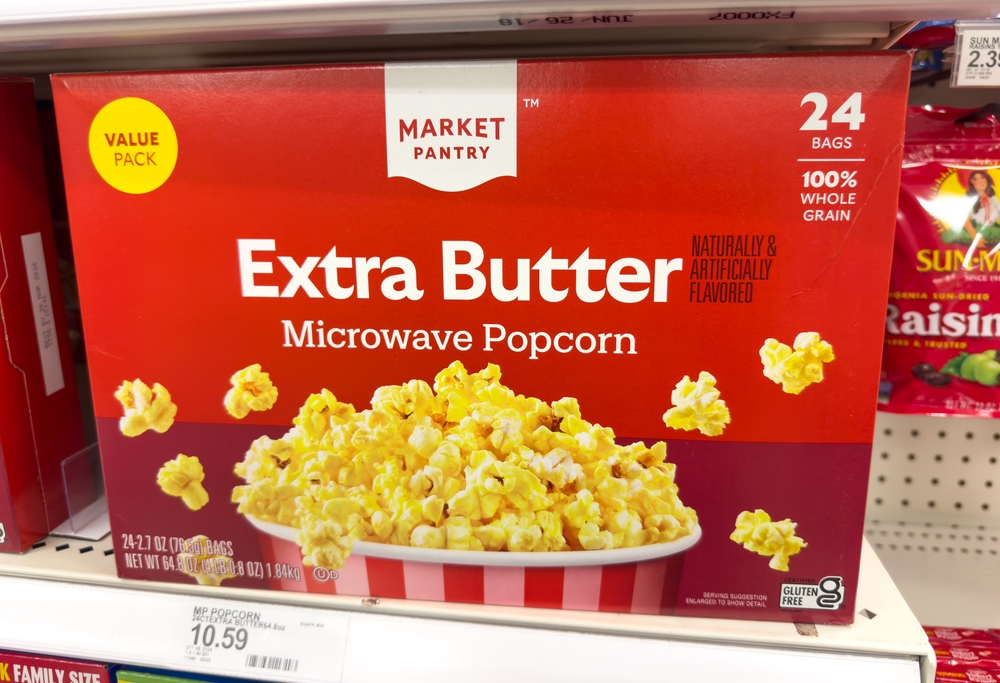
There’s something almost magical about the smell of fresh microwave popcorn—warm, buttery, and ready in minutes. But what many people don’t realize is that beneath that crinkly paper bag lies a chemical surprise that’s far less appetizing. Recent research has shed light on substances used in the lining of microwave popcorn bags that may have potential health risks. Even though these chemicals make the bags resistant to oil and heat, they can also linger in the body far longer than you might expect. If you’ve ever wondered what’s really behind that buttery aroma, this might change the way you snack forever.
The Chemical: Perfluorooctanoic Acid (PFOA)
For years, manufacturers used a chemical called perfluorooctanoic acid, or PFOA, in the lining of microwave popcorn bags. This synthetic compound belongs to a group known as PFAS—often called “forever chemicals” because they don’t break down easily in the environment or the human body. PFOA helps prevent grease from leaking through the bag, keeping your popcorn crisp instead of soggy. However, studies linked long-term exposure to PFOA with health issues like thyroid disease, high cholesterol, and even certain cancers. Although major U.S. manufacturers phased it out around 2015, some imported or older brands may still contain similar PFAS compounds today.
Why PFAS Are So Persistent
PFAS chemicals—short for per- and polyfluoroalkyl substances—were once celebrated for their versatility. They’re resistant to heat, water, and oil, making them perfect for cookware, packaging, and textiles. The downside? Their chemical bonds are nearly unbreakable. That means when you ingest trace amounts—whether from food wrappers, water, or microwave popcorn—they can accumulate in your body over time. The CDC has even found PFAS in the blood of most Americans, suggesting just how widespread the exposure really is.
How These Chemicals End Up in Your Popcorn
When you heat a bag of popcorn, the high temperatures cause PFAS coatings to break down, releasing particles that can migrate into the popcorn itself. The butter flavoring oils can absorb these substances, which you then consume along with your snack. Over time, these small exposures can add up, particularly for people who eat microwave popcorn frequently. Scientists have called this a “low-dose, high-frequency” exposure pattern—small amounts that persist in the body. It’s a reminder that convenience often comes with hidden costs to health.
What Health Experts Are Saying
Health organizations, including the Environmental Protection Agency (EPA), have taken growing concerns over PFAS seriously. The EPA now lists PFOA and similar chemicals as potential carcinogens and recommends minimizing exposure whenever possible. Researchers from Harvard and the Environmental Working Group have linked these substances to immune system disruption and liver damage in long-term studies. While occasional exposure isn’t likely to cause immediate harm, the cumulative effect over the years is what worries experts most. In short, it’s not about one bag of popcorn—it’s about what builds up quietly over time.
Safer Popcorn Alternatives
If you’re not ready to give up your favorite movie-night snack, don’t worry—there are safer ways to enjoy popcorn without the unwanted chemicals. One easy swap is using an air popper, which pops kernels using hot air instead of oil or coated bags. You can also make homemade stovetop popcorn in a pot with a lid and a small amount of olive or coconut oil. For that buttery flavor, add real melted butter or nutritional yeast for a healthier twist. Not only will it taste fresher, but you’ll also avoid exposure to microwave popcorn chemicals entirely.
How to Spot Safer Brands
If you prefer the convenience of microwave popcorn, look for brands that specifically label their bags as PFAS-free. Many newer companies have reformulated their packaging to remove harmful coatings. Read the ingredient list carefully and check for certifications like “non-toxic packaging” or “BPA and PFAS-free.” You can also research the brand’s safety statements online before buying. As consumers have become more aware, the market has shifted toward transparency and healthier materials.
The Bigger Picture of Chemical Exposure
Microwave popcorn isn’t the only product affected by PFAS chemicals—they’ve been found in fast-food wrappers, pizza boxes, nonstick pans, and even raincoats. It’s part of a larger conversation about what goes into our everyday products and how much we really know about them. The good news is, awareness leads to change. As demand for safer products grows, more companies are adopting sustainable, chemical-free alternatives. The small act of reading labels or switching brands can create a ripple effect that benefits everyone.
Popcorn Without the Hidden Price Tag
Enjoying popcorn shouldn’t come with a side of concern. By understanding what’s in your bag, you can make smarter choices that protect both your health and the environment. Whether you switch to stovetop popping or stick with trusted PFAS-free brands, every small change counts. The more informed we are as consumers, the less room there is for hidden ingredients to go unnoticed. After all, the best kind of snack is one that leaves you satisfied—not worried.
Have you ever checked whether your microwave popcorn is PFAS-free? Share your favorite healthy popcorn tips in the comments below.
What to Read Next
- 8 Car Wash Chemicals That Destroy Vehicle Value
- Are Chemical Sunscreens Safe? Here’s What the Latest Research Really Says
- Toxic Home: 8 Household Chemicals Toxic to Kids
- 7 Autumn Foods That Drive Testosterone Levels Downhill
- 9 Power Foods That Fuel Endurance in Men
The post Did You Know Microwave Popcorn Bags Contain This Surprising Chemical? appeared first on Clever Dude Personal Finance & Money.







